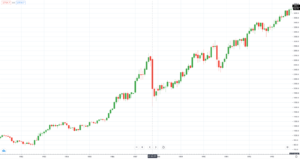Solar and Lunar Eclipses in 2019
Why Do Eclipses Happen?
Why eclipses occur
Eclipses of the Sun or Moon can only occur when the Moon crosses the plane of Earth’s orbit (orange circle) very close to the time of new or full Moon. Eclipse “windows” occur six months apart.
Jay Anderson
A solar eclipse, such as the one in August 2017, occurs only at new Moon, when the lunar disk passes directly between us and the Sun and the Moon’s shadow falls somewhere on Earth’s surface.
Conversely, a lunar eclipse takes place during full Moon, when our satellite passes through Earth’s shadow.
These alignments don’t happen at every new and full Moon because the lunar orbit is tipped about 5° to Earth’s orbital plane — only occasionally do the Sun, Earth, and Moon line up exactly enough for an eclipse to occur. (The technical name for that, by the way, is syzygy.) And, as the diagram above implies, those alignments occur roughly six months apart. In 2019, for example, two eclipses occur in January, two in July, and one in late December.
Three types of lunar eclipse are possible (total, partial, and penumbral) depending on how deeply the full Moon plunges into or near the umbra, our planet’s dark, central shadow.
Partial lunar eclipse, eclipses in 2017 won’t include great lunar eclipses.
A long-exposure image captured red hues on the portion of the Moon inside the umbra during the lunar eclipse on October 8, 2014.
Johnny Horne
If it goes all the way in, we see a total lunar eclipse that’s preceded and followed by partial phases. That was the case during the widely viewed event in September 2015, which marked the conclusion of a series of four consecutive total lunar eclipses in 2014–15! Such eclipse tetrads are not common — the last one occurred during 2003–04, but the next won’t begin until 2032.
If the Moon skims part way into the umbra, as shown at right, only the partial phases occur — you’ll see part of the Moon in nearly full sunlight, and part of it steeped in the deep, red-tinged umbral shadow.
And if its disk passes just outside the umbra, it still encounters the weak penumbral shadow cast by Earth. A sharp-eyed observer will notice that one side of the full Moon’s disk looks a little dusky.
Fortunately, every lunar eclipse is observable anywhere on Earth where the Moon is above the horizon. (But there’s still an element of luck involved — after all, the sky has to be clear!)
However, solar eclipses more tightly restrict where you can see them because the Moon casts a smaller shadow than Earth does.
If the Moon completely hides the Sun, the eclipse is considered total. With its brilliant disk completely covered, the Sun’s ghostly white outer atmosphere is momentarily revealed for durations from seconds to several minutes. In November 2013, for example, planeloads of eclipse-chasers converged in a remote portion of northern Kenya to watch just 11 seconds of totality.
Corona during August 2017 solar eclipse
Here’s how the corona looked during the total solar eclipse seen across the U.S. on August 21, 2017.
Sky & Telescope / Kelly Beatty
A completely eclipsed Sun can be viewed only from a narrow track or path on Earth’s surface that’s typically just 100 miles (160 km) wide. Outside of that path, about half of the daylit hemisphere of Earth is able to watch a partial eclipse as the Moon obscures a portion of the Sun.
Occasionally the Moon passes directly in front of the Sun but doesn’t completely cover it. When that occurs, it’s usually because the Moon is farther from Earth than its average distance. (The Moon’s orbit isn’t perfectly circular; its eccentricity is about 5%.)
This geometric circumstance is known as an annular eclipse, so-called because you can see a ring, or annulus, of sunlight surrounding the lunar disk. Annular eclipses of the Sun occur about as often as the total ones do, and an annular’s path is likewise narrow. Outside of it observers see only a partial cover-up.
The Five Eclipses in 2019
Below are brief descriptions of this eclipses in 2019 of the Sun and Moon. You’ll find more details Sky & Telescope magazine as the date of each draws near. Times are in Universal Time (UT) except as noted. Adjust these to get those for your time zone: for example. PST = UT – 8, and EST = UT – 5. (But be sure to allow for daylight or “summer” time: PDT = UT – 7, and EDT = UT – 4.)
January 6: Partial Solar Eclipse
The year starts off with a bang, eclipse-wise, with a partial solar eclipse during the first week of January. But to see the Moon take its biggest bite out of Sun — the location of greatest eclipse — you’ll need to venture to the bleak outpost of Srednekolymsk in central Siberia. (Hey, at least it’s got an airport.) There you’ll brave an average daytime high of –28°F to witness 62% of the Sun’s disk tuck behind the Moon. The obscuration and the weather are less dramatic elsewhere in northeastern Asia and the North Pacific Ocean. About 20% of the Sun is covered from Beijing, 30% from Tokyo, and 37% from Vladivostok. More information about this eclipse.
January 20–21: Total Lunar Eclipse
Here are key events for the total lunar eclipse on January 20–21, 2019.
Leah Tiscione / Sky & Telescope
It’s been more than three years since everyone in the U.S. has experienced a total lunar eclipse — the last one was September 27–28, 2015 — and skygazers are hungry for another! As the graphic at right shows, the eclipse will last almost 3½ hours from the beginning of the partial phase at 3:34 UT until it ends at 6:51 UT. Totality lasts 63 minutes, from 4:41 to 5:44 UT.
The timing of this one, with mid-eclipse at 5:12 UT, gives everyone in North America a ringside seat — though it’ll be a late night for anyone on the East Coast. As veteran skywatcher Joe Rao notes in Sky & Telescope’s January issue, the eclipsed Moon will appear high in a mid-winter sky, and this event occurs on the Sunday night of a 3-day holiday weekend in the U.S. So if it’s clear that night, you’ll have no (good) excuse for skipping this wonderful celestial event.
The diagram at upper right and the table below show you what to look for and when (UT times are all for January 21st; local times are on the 20th if “p.m.” and the 21st if “a.m.”):
Up to seven eclipses of the Sun and Moon can take place in one year, though the last time that happened was 1982, and the fewest possible is four. The mix of five events occurring in 2019 is especially interesting, because no two will be alike! There’ll be three different types of solar eclipse — one each of partial, annular, and total — along with a total and a partial lunar eclipse.
Article Source : https://www.skyandtelescope.com/observing/solar-and-lunar-eclipses-in-2019/
















